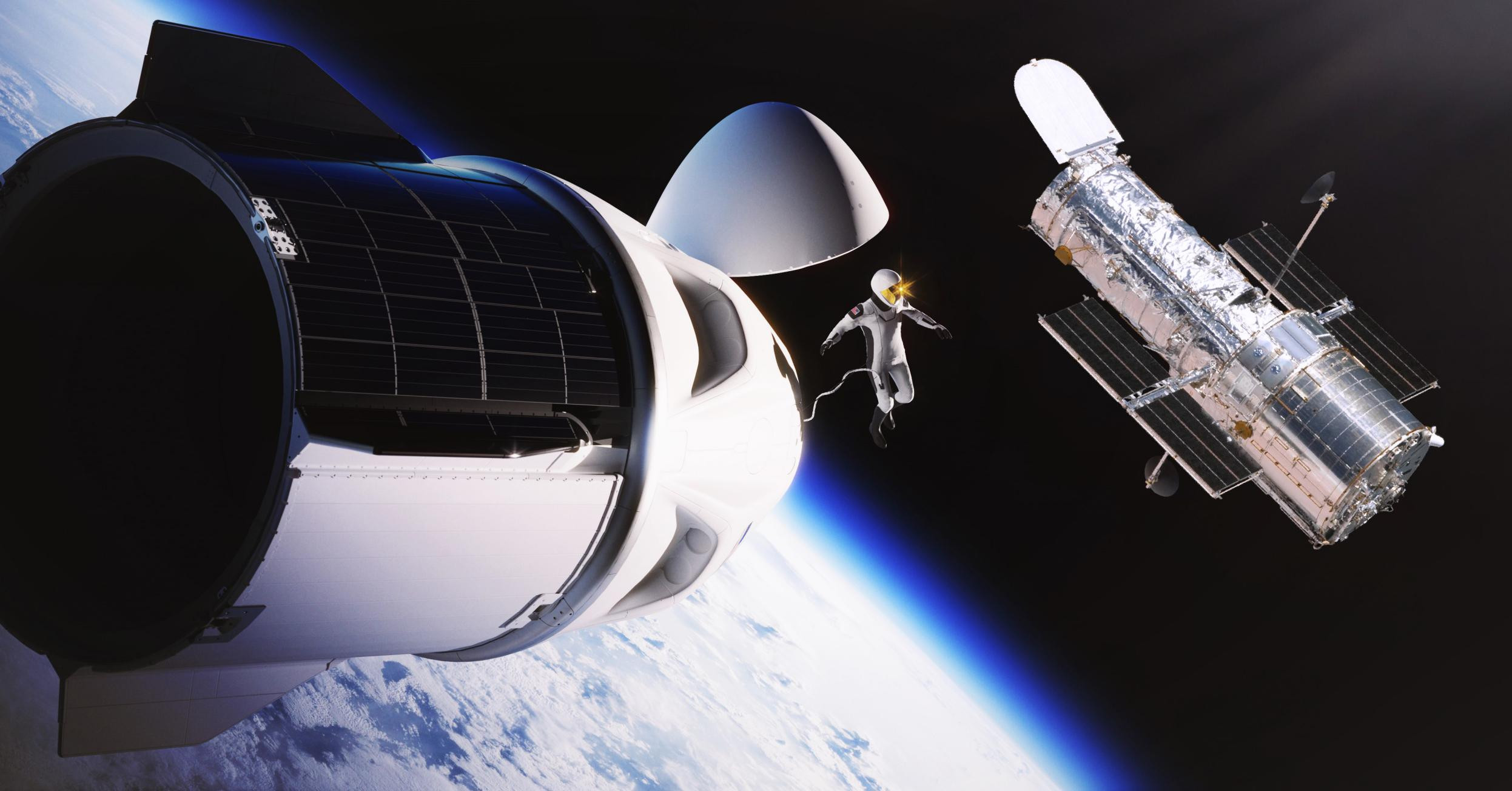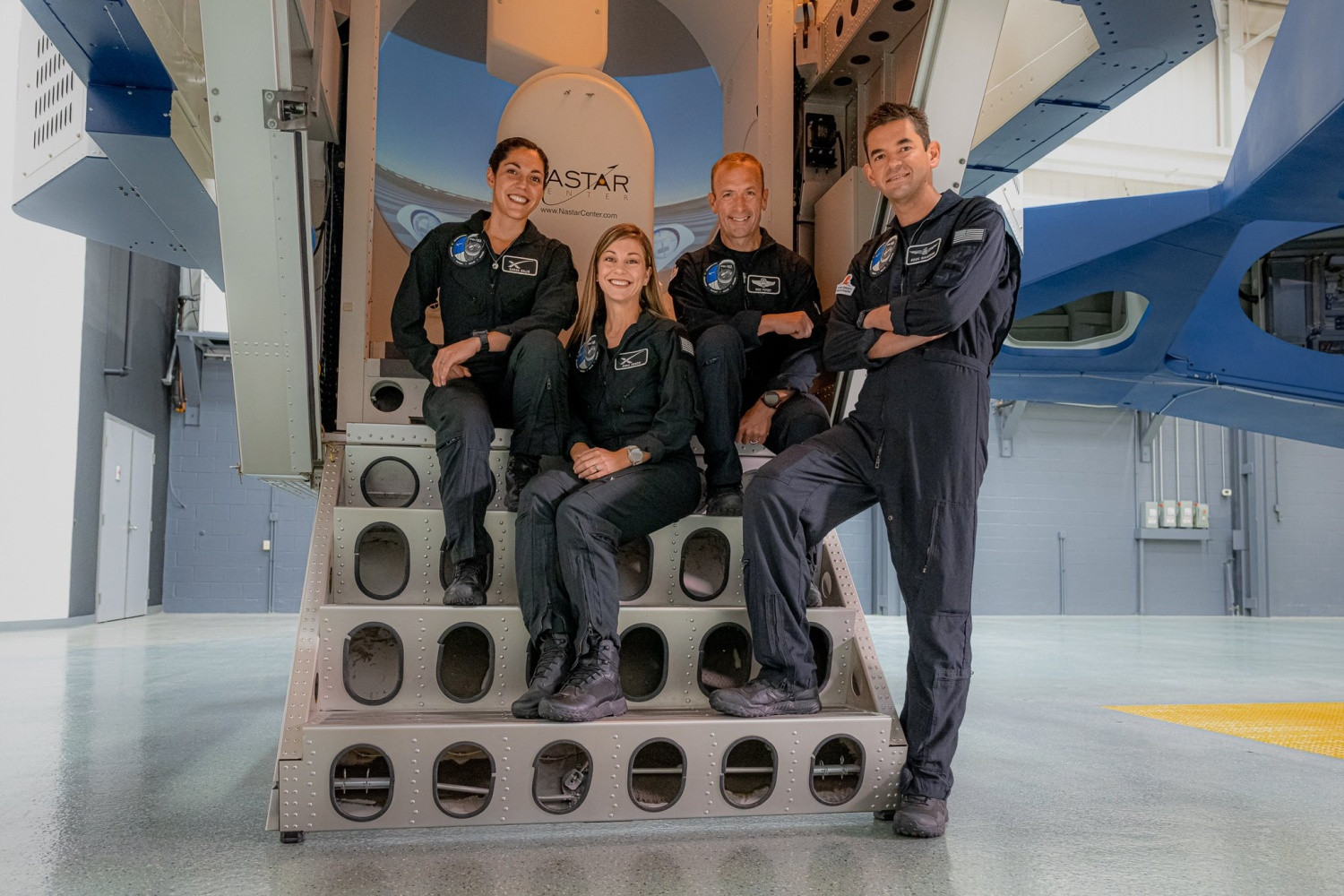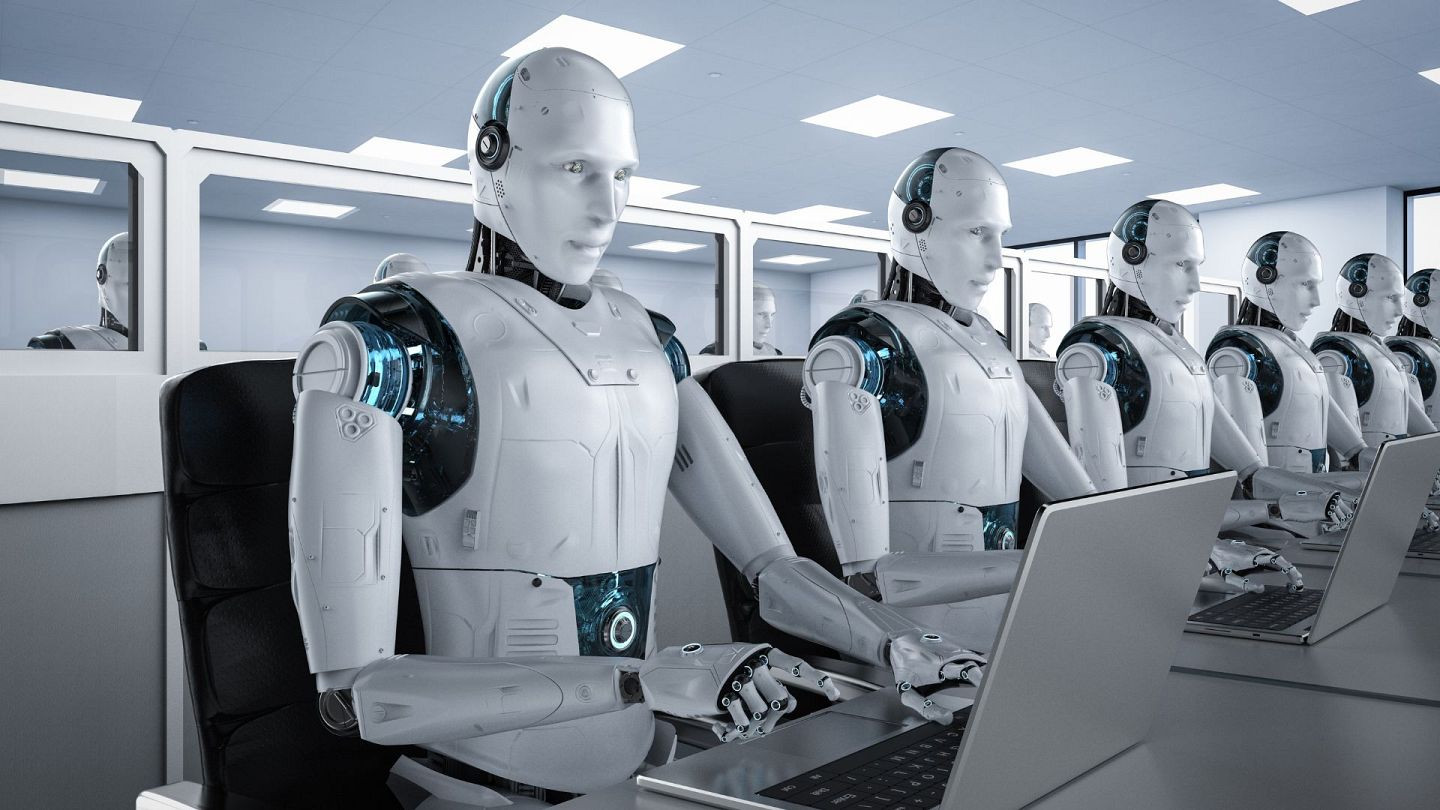NASA researchers will soon benefit from a suite of experiments flying aboard a new fully-commercial human spaceflight mission, strengthening future agency science as we venture to the Moon, Mars and beyond.
The experiments are flying as part of the Polaris Dawn mission which launched aboard a SpaceX Dragon spacecraft and Falcon 9 rocket earlier today.
The four-person Polaris Dawn crew of Jared Isaacman, Scott “Kidd” Poteet, Sarah Gillis, and Anna Menon will conduct science during the mission including essential health and human performance research for NASA’s Human Research Program. The research will help NASA scientists better understand how exposure to space conditions affects the human body. The crew will test new medical approaches and technology on telemedicine capabilities, gather data on space motion sickness, and better characterize flight-associated injury risks.
“Each mission, whether the crew is comprised of commercial or NASA astronauts, provides a key opportunity to expand our knowledge about how spaceflight affects human health,” said Jancy McPhee, associate chief scientist for human research at NASA. “Information gathered from Polaris Dawn will give us critical insights to help NASA plan for deeper space travel to the Moon and Mars.”
The crew will test drive, a commercial device that can collect and integrate measurements of health, including blood pressure, heart rate, respiration rate, and temperature. The technology also provides ultrasound imaging and larynx and throat-focused video camera capabilities, and includes an experimental telemedicine feature that could help diagnose crew members in near-real time.
To test this technology during the mission, crew members will compare vital sign collection from the device with data gathered from standard periodic health status exams. The technology’s telemedicine feature, which relies on SpaceX’s Starlink communications system to connect with doctors and specialists on Earth, will also be tested during a simulation. During the test, the device will attempt to offer an appropriate diagnosis based on crew inputs and available documentation.
“Crew members will need to be more self-reliant during lengthy missions, and we hope that telemedicine can provide crews with assistance,” said McPhee.
Another research project aims to better understand and prevent the motion sickness symptoms that many astronauts experience in space. Participating crew members will describe their motion sickness symptoms, what interventions they tried to alleviate their symptoms, and whether any approaches helped.
A separate NASA-based research project will survey crew members after their mission to see whether they experienced any injuries or discomfort during re-entry to Earth.
“Our team will take the crew’s survey data and combine it with information gathered from sensors on the spacecraft. This will allow us to link crews’ reported experiences and health outcomes with the spacecraft’s dynamics and landing loads,” said Preston Greenhalgh, an injury biomechanist at NASA who is leading this work.
Crew members also will participate in a variety of other health studies on behalf of the NASA-funded TRISH (Translational Research Institute for Health), a consortium with various academic institutions. As part of that work, the Polaris Dawn mission will set a new baseline for collecting standard health data on commercial spaceflights, creating a complement to the datasets routinely collected from NASA astronauts and missions.
Polaris Dawn crew members participating in these TRISH studies will provide data about how spaceflight affects mental and physical health through a rigorous set of medical tests and scans completed before, after, and during the mission. The work will include assessments of behavior, sleep, bone density, eye health, cognitive function, and other factors, as well as analysis of blood, urine, and respiration.
“We’re so grateful to the crew members who volunteer to be part of NASA’s work. The insights that we gain from each study may trigger breakthroughs that will help ensure future mission success,” said McPhee.
Testing Starlink Laser Communications
The Polaris Dawn mission, in which a crew of four civilians will attempt the first civilian spacewalk, will also test out Starlink laser communications aboard the Dragon spacecraft.
SpaceX launched the Polaris Dawn mission early Tuesday at 5:23 a.m. ET from Cape Canaveral, Florida. A crew of four civilians in a SpaceX Dragon spacecraft will spend five days in orbit and attempt the first commercial spacewalk.
Among the mission objectives is also to test Starlink laser-based communications in space, which SpaceX said could inform future space communications systems for missions to the Moon, Mars and beyond.
SpaceX said that this will be the first mission to test Starlink laser communications. SpaceX installed what it is calling the “Plug and Plaser” lasercom system inside the trunk of the Dragon spacecraft to communicate with Starlink satellites throughout the mission. A Starlink router was installed inside Dragon’s cabin.
SpaceX has been launching Starlink satellites equipped with laser communications since early 2021. In March of this year, Gwynne Shotwell, president and COO of SpaceX, announced that SpaceX planned to commercialize its laser technology and call it “Plug and Plaser,” in comments at SATELLITE 2024.
“We are going to roll out a capability, we call it ‘plug and plasers’ — [to] commercialize our lasers to put on other satellites systems,” Shotwell said in March. “We’ll roll that out with our new Polaris Dawn mission coming up this summer on Dragon capsules — so we’ll connect Dragon to the internet. I’m really looking forward to having communications to bases on the Moon, and Starlink around Mars.”
A Historic First: The Private Spacewalk
The Polaris Dawn mission will flying higher than any previous Dragon mission to date and reaching the highest Earth orbit ever flown. Astronauts also will test the newly developed SpaceX EVA spacesuits and perform scientific research.
A SpaceX rocket lifted off early Tuesday morning carrying four astronauts who hope to conduct the world’s first commercial spacewalk. The launch from the Kennedy Space Center in Florida marks the beginning of one of SpaceX’s highest-stakes missions yet.
If all goes as expected, in a matter of days, Internet entrepreneur Jared Isaacman and SpaceX engineer Sarah Gillis will be the first private astronauts to exit their spacecraft to float above the Earth in spacesuits. They’ll be treated to a majestic view of the planet that’s only been seen by professional astronauts working on official missions from their space agencies.
But experts warn there’s plenty that could go wrong. Spacewalking carries unique risks compared to traveling inside a capsule or visiting the International Space Station. This mission will use several components that have never been tested in space before, including the spacesuits themselves. And it will require skill and cool-headed thinking from the astronauts involved, three of whom have never been to space at all.
Conducting a spacewalk like this is a “risky adventure,” acknowledges Bill Gerstenmaier, SpaceX’s vice president of build and flight reliability, who previously headed NASA’s human spaceflight operations.
But he insists that the company is ready: “We’re going to do it as safely as we can, and we’ve got the right protocols and we’ve done the right testing to get ready to go,” Gerstenmaier told reporters at a press briefing last month.
The mission, known as Polaris Dawn, is a giant leap for commercial space travel. To date, most space tourists have either taken a brief suborbital journey that provides a few moments of weightlessness, or (for significantly more money) traveled to the International Space Station. Isaacman spent a few days in 2021 orbiting earth in a SpaceX capsule.
He’s now paid an undisclosed sum of money for this mission, which is the first of three scheduled as part of the Polaris program. Isaacman had floated the idea of the second mission being used to service the Hubble Space telescope, but NASA recently said the agency would not pursue it at this time because they’re not sure it’s worth the risks.
On this mission, all four astronauts will don new SpaceX spacesuits before purging the air from their Dragon capsule. Isaacman, the mission commander, and Gillis will then open the hatch and float briefly out of the capsule, connected by umbilical cords that will supply them with oxygen. The mission’s pilot, Scott Poteet, and medical officer and SpaceX employee Anna Menon will remain inside the capsule.
The Risks and Rewards of Spacewalks
The allure of doing a spacewalk is clear. The view is stunning, says Luca Parmitano, an astronaut for the European Space Agency who has conducted six spacewalks.
“It’s almost as if time stops for a second, or your heart stops for a second, it’s just so beautiful,” he says.
But Parmitano says that spacewalking is also physically and mentally challenging. The suits are pressurized, making them stiff and inflexible.
“At one point during the spacewalk, you’re going to be hot, you’re going to be cold, your hands are going to hurt,” he says. “You have to embrace the suck.”
And there’s a lot that can go wrong. During a spacewalk outside the International Space Station in 2013, Parmitano’s helmet began filling with water from his spacesuit’s cooling system. In zero G, the capillary pressure caused the water to stick to his skin and begin creeping around his head.
“It covered my eyes, it covered my ears, it went inside my nose,” Parmitano recalls. He was unable to communicate because his radio no longer worked. “I was on my own, isolated. I couldn’t see anything, I couldn’t hear, I couldn’t talk.”
Spacewalks (known in the business as Extravehicular Activities, or EVAs), have always been among the most dangerous parts of space travel. During the first American spacewalks carried out during the Gemini program of the 1960s, crew members frequently experienced problems with their suits, according to Emily Margolis, a curator of contemporary spaceflight at the Smithsonian National Air and Space Museum.
“Of the nine EVAs that took place during project Gemini, three of them actually ended early due to concerns over health and safety,” Margolis says.
For example on Gemini 9, astronaut Gene Cernan was supposed to test a kind of rocket pack to help astronauts move around in space. His suit included a metallic coating to protect him from the exhaust of the rocket pack, but the coating made it far harder to move.
One of the paradoxes of spacewalking is that, although space is cold, the lack of atmosphere around the suit can actually cause heat to build up inside. As Cernan struggled to move, he ended up overexerting himself.
“He started to sweat profusely and the moisture in the suit started to fog his vizor,” Margolis says. With his visibility severely impaired, his crewmate cut the EVA short and brought him back inside.
When Cernan returned to Earth, Margolis says, it was determined he’d lost 13 pounds over the mission. “It’s believed that most of that was water weight from the amount that he was sweating during this EVA,” she says.
Spacewalks have become more routine since then, but they remain risky, according to Jonathan Clark, a physician at Baylor College of Medicine who has consulted for both NASA and SpaceX on spacesuits. By his count, around one in five spacewalks encounter some sort of problem.
“Sometimes you can adapt to it, but a lot of times you’ve got to stop the EVA and come back in,” he says.
In the case of Luca Parmitano, the astronaut whose helmet began filling with water, he had little choice but to cut the spacewalk short. Because he couldn’t see, he had to work his way back to the airlock from memory. Eventually fellow spacewalker Chris Cassidy helped him get back inside and close the hatch.
“I don’t take any specific credit for keeping my cool because I’d been trained my whole adult life to perform in relatively risky situations,” says Parmitano, who is also a colonel and test pilot in the Italian Air Force.
Clark notes that the Polaris Dawn crew has had far less experience. Of the four crewmembers, only Isaacman has actually been to space.
Beyond that, “none of the crew has done an actual spacewalk before,” he says. “It’s going to be a first for everybody.”
The crew will be wearing new SpaceX suits that in some ways resemble those worn by earlier generations of astronauts. They will be fed oxygen by an umbilical cord connected to the spacecraft, and the suits themselves will be passively cooled with air from the umbilical. That means there’s no chance of a water leak, like what happened to Parmitano, but overheating similar to the Gemini missions could become an issue, as could fogging of the astronaut’s visors.
Moreover, the Dragon Capsule itself will have to continue to operate smoothly under vacuum. Without air circulating, the capsule’s onboard computers will have a harder time keeping cool.
“The challenges are certainly there,” Clark says.
But newbies can do tough things in space. Sian Proctor was the pilot of Isaacman’s first mission to orbit the earth in 2021. Until six months before launch, she’d never flown a rocket.
“I basically went from being a geoscience professor to being a mission pilot of a spacecraft,” she says.
Proctor says SpaceX got her ready. In fact, Sarah Gillis helped train her for her mission. Another member of this latest crew, Scott Poteet, was the mission director for her launch.
While Proctor’s brief flight took only six months to prepare for, this latest mission has been in the works for more than two years, allowing for much more training.
Proctor says, If anyone can carry out the first commercial spacewalk, it’s this team.
“The crew is amazing,” she says. “They are so competent at what they do.”
Polaris Dawn: A Milestone in Private Space Exploration
SpaceX announced that on Tuesday, September 10 at 5:23 a.m. ET, Falcon 9 launched Polaris Dawn to low-Earth orbit from Launch Complex 39A at NASA’s Kennedy Space Center in Florida.
During their multi-day mission to orbit the passengers will attempt the first spacewalk of private astronauts, using spacesuit technology developed by SpaceX, and ascend to 1,400 kilometers, the highest orbit with humans since the Apollo 17 moon mission.
They will also test laser-based communications with Starlink a satellite broadband provider, and conduct 36 research studies and experiments from 31 partner institutions designed to advance both human health on Earth and during long-duration spaceflight, and test Starlink laser-based communications in space.
Following stage separation, Falcon 9’s first stage landed on the Just Read the Instructions droneship stationed in the Atlantic Ocean.
The Polaris Dawn mission marks a significant leap forward for private space exploration, demonstrating the growing capabilities of commercial space companies and their ability to conduct complex and groundbreaking missions. The mission is a testament to the dedication and expertise of the crew, SpaceX engineers, and the countless individuals who have contributed to its success.
The crew’s success in conducting the first-ever commercial spacewalk and testing Starlink laser communications will have lasting implications for the future of space travel and exploration. It paves the way for more ambitious private missions, including trips to the Moon and Mars, and underscores the role that commercial companies will play in shaping the future of space exploration. As we venture further into space, missions like Polaris Dawn will continue to push the boundaries of what is possible, inspiring generations to come.


















